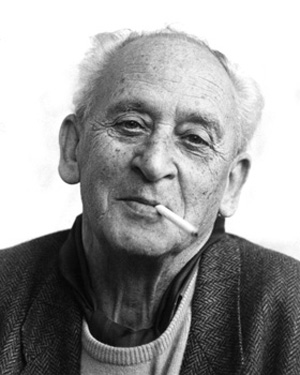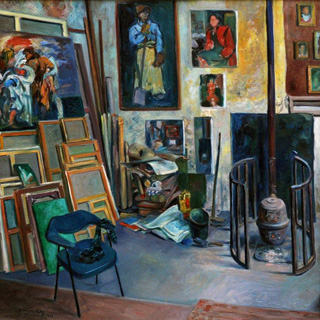![]() This website is dedicated to my father, Boris Taslitzky and aims to make accessible and introduce to a larger public, the entirety of his works.
This website is dedicated to my father, Boris Taslitzky and aims to make accessible and introduce to a larger public, the entirety of his works.
As a man of wit and action, he bravely engaged with deeply tragic events that left indelible imprints on his life and consciousness. Yet, he always considered himself first and foremost, an artist. His work reflects a spectrum of styles and sensibilities from the 20th century and this is a testament to both his brilliance and importance.
Artistically, literally and historically aware, he positioned himself among the realist artists who belonged to the French tradition. He was a man with a courageous heart; a humanist and an artist who regardless of the circumstances, portrayed life in all its dimensions. His work fostered both political and social engagement and delicately captured the various shades of joy, outrage and all that lay in between. It is to this man, this artist and humanist that I pay tribute and of course, to this man I call my father.
I am thankful to all those who supported the creation of this website and in particular, to Isabelle Rollin-Royer, the original creator and author of a majority of the introductory paragraphs and original photographs; to Marie-Christine Auzou for her photographs of the paintings and drawings; to Christophe Cognet for allowing us to use his film; to Jean-Francois Cornuet for having created the website and to the museums and private collectors who shared my father's works and photographs that were in their possession.
Évelyne TASLITZKY
A painter of Russian origin, the Frenchman Boris Taslitzky (1911-2005) was born in Paris where he spent his whole life. His artistic sensibilities were revealed early on. At the early age of 15 he attended the academies of Montparnasse followed by the National school of Fine Arts in Paris (École Nationale des Beaux-arts de Paris). It was there that he was supported by George Besson, Francis Jourdain and Louis Aragon. His studio became the meeting point for prominent intellectual and artistic personalities. His painting style is firmly affiliated to the French tradition – from Poussin to Fragonard, Ingres, Gericault, Delacroix and Courbet.
His artistic development was strongly influenced by the upheavals of the 20th century. As an actor and witness of history, his artistic and political involvement was a measure of a consciousness that stemmed from an acute sense of humanitarian responsibility. In 1933 he joined the Association of Revolutionary Writers and Artistes (AEAR) within which he was appointed as General Secretary heading the Painters and Sculptors division. In 1935 he joined the Communist Party. As an author of realist affiliation, he assumed active roles in debates hosted by the Culture House (Maison de la Culture) and helped shape the Popular Front's cultural policy.
Boris Tasliztky stated that his whole life was marked by war. After the upsurge of the 1905 Revolution, his parents fled Russia to settle in Paris. At the onset of World War One in 1915 his father was killed on the French side of the battlefield. In 1942, his mother was arrested and murdered by the Nazi Regime in Auschwitz. From the beginning, Boris Taslitzy was resolute in his commitment to the French Resistance. Even after imprisonment, he managed to escape. Following his escape, he was found guilty of producing engaged drawings and was arrested once again. His perceived 'defiance' did not subside following incarceration and in the multiple locations he served out his imprisonment – firstly in the jails of Vichy, then in the central command of Riom and finally in the camp of Saint Sulpice-La-Pointe. It was in this last location that he painted frescos with the help of his fellow inmates. This secured him the title of 'Master of Saint Sulpice' – attributed to him as a result of an article by Aragon, published in the magazine "Regards". Despite the inhuman conditions within the Nazi concentration camp of Buchenwald, Boris Taslitzy produced almost two hundred drawings and sketches, as well as 5 watercolours. Paying tribute to his fellow painter's courage and talent, Aragon published the portfolio '111 Drawings made in Buchenwald' in 1946. In 1978 it was also featured in its second edition as an enlarged portfolio by the French Association, Buchewald-Dora as Biro Editeur edition. In 2006, the Museum of Jewish Art and History dedicated an exhibition to this exceptional visual testimony.
Boris Taslitzky's military involvement and commitment to justice and freedom is palpable in his works. In 1952, at the awakening of the insurrection he was invited to produce works (along with the painter Mireille Miailhe) by the Algerian Communist Party. Together they engaged in the production of a set of drawings that condemned the surrounding conditions of misery. The two created paintings which were later exhibited in the Parisian gallery Andre Weil in January 1953. The exhibition generated much controversy.
He submitted satirical drawings to the newspaper Ce soir and edited Tu parles… (You speak) an autobiographical chronicle and Tambout battant, a collection of short stories. Meanwhile his studies were also published in Les Lettres françaises, L'Humanité, France Nouvelle, La Pensée, Europe and La Nouvelle Critique.
In 1946 he was awarded the Blumenthal Prize as an acknowledgement of his visual and creative eloquence. His excellent critical approach in shaping theory coincided with his political engagement and his dedication to the valorisation of art and the desire to support his fellow artists.
Encouraged by the sculptor Jacques Lipchitz, in his early days he frequently visited the Louvre. During this time, Boris Taslitzky cultivated a deep passion for Gericault. The 11th issue published in the edition of the Société des amis de Louis Aragon et Elsa Triolet presents an anthology of his essays on art – all of which attest to his expertise and grasp of the subject matter. In his works, he focuses on the past in an attempt to better understand the present, while also believing in its importance for the shaping of the future. His writings question both the work of his contemporaries such as Gromaire, Lurcat, Gimond, Giacometti and those he admired such as Gruber and Amblard.
His commitment to learning and knowledge was given an outlet in his position as drawing professor between 1971 and 1980 at the Ecole nationale supérieure des Arts Décoratifs.
His entire life has been characterised by his great attention to the joys and sorrows of others – his empathy. It is, in fact, his natural disposition and his curiosity concerning the world and interest in those who surround him, which fuel the roaring creative engine and the extraordinary artistic creations of Boris Taslitzky. He was constantly drawing everywhere, with countless sketchbooks. Occasionally his drawings served as preparatory sketches to paintings. In addition to his political works he also produced fine still-lives, landscapes and many portraits. He is famously quoted as saying: I collect portraits in the same manner others collect butterflies. Christophe Cognet's biographical film L'atelier de Boris gives an insight into the artist's exceptional observational ability in representing both daily and historically known events. Regardless of the states of things, Boris Taslitzky was always capable of rendering reality no matter how painful or tragic it appeared – even to the point of the unbearable. If I went to hell I would make sketches. In fact, I have lived that experience, I was there and I drew.
Despite being affiliated with the French tradition of Realism, a portion of his paintings, drawings and writings attest to his status as military artist. It would however be reductive to consider only the political dimension of his work. His weapons were his use of colour and choice of words. Few artists are able to present such holistic coherence within their creations. The cohesion and rich dynamism of his life are expressed in his work, from his thought to his drawings, from painting to writing. All are remarkable.
In France and abroad the works of Boris Taslitzky are preserved in many private collections as well as in many prestigious public collections, including the Musée National d'Art Moderne, Musée d'Art Moderne de la ville de Paris, Musée des années 30 in Paris, the Pouchkine Museum in Moscow and the Tate Modern in London.
Boris Taslitzky received the War Cross Award 1939-45 and the French military medal. He was also honoured with the Chevalier de la Légion d'Honneur, Chevalier des Arts et Lettres, as a voluntary fighter in the Resistance.

